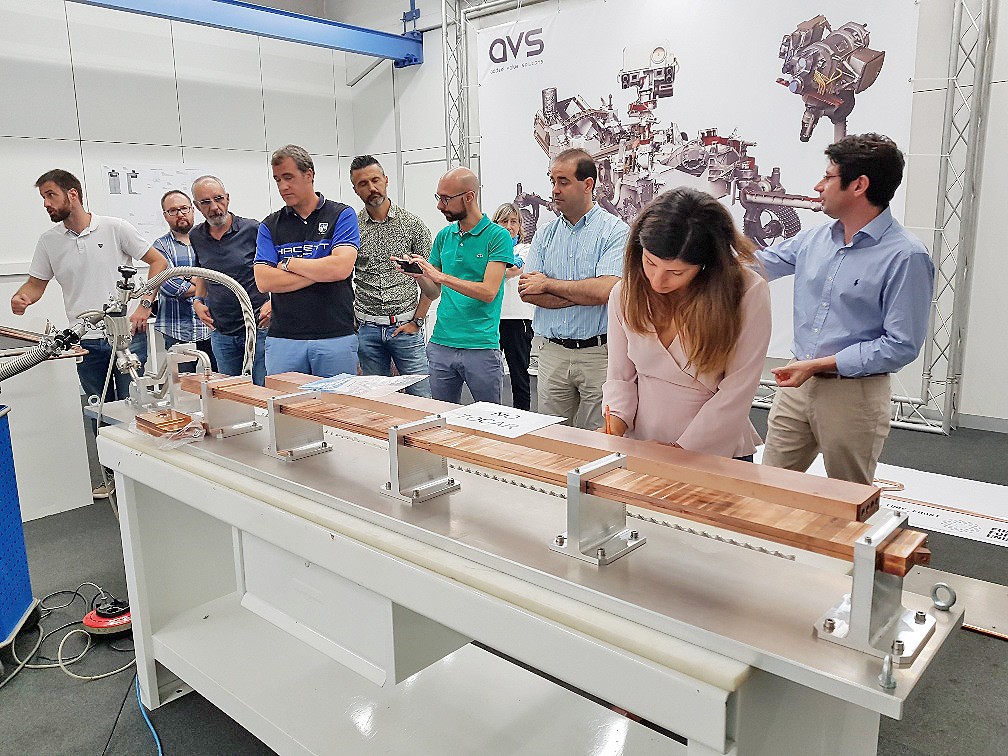F4E and AVS-TECNALIA consortium to produce the beam line components of MITICA

Representatives of F4E, Consorzio RFX, ITER Organization, AVS-TECNALIA consortium checking prototypes produced by AVS-TECNALIA consortium
MITICA is an international experiment located in Padua, Italy, hosted by Conzorzio RFX, part of the ITER Neutral Beam Test Facility (NBTF). Its mission is to help scientists to develop some of the heating systems required to achieve the high temperature of ITER’s super-hot plasma. Due to the particularities of the biggest fusion device, scientists around the world have agreed to validate some niche technologies before deploying them. For this reason, a Neutral Beam Injector (NBI) is being developed on the same scale with the ones that will operate in ITER. It will deliver up to 16.7 MW of neutral particles at 1MeV of energy.
Europe is one of the main contributors of the NBTF. With regards to MITICA it has undertaken the obligation to deliver a big part of the equipment such as power supplies, the cryoplant, cooling, vacuum and gas introduction systems, the SF6 plant, and all main injector components (beam source, vacuum vessel, etc.). F4E has signed a contract with Spain’s AVS–TECNALIA consortium for the production of MITICA’s beam line components, which should be delivered in four years. This is the last major contract awarded by F4E to the NBTF.

Works for the beam line components gathered pace towards the end of 2017. After the specifications were prepared, F4E started working in parallel with three different contractors. The result of this collaboration generated three prototypes each addressing critical technologies necessary for the fabrication of the beam line components and ultimately, refined industrial and manufacturing specifications. The successful bidder – AVS, Fundación Tecnalia – will now have to deliver one neutraliser, one electrostatic residual dump, one calorimeter and auxiliary equipment. All of these components will need to be aligned with the beam source and will be installed in the vacuum vessel’s adjustable beds.

What will be the main function of these components? Mainly to remove the electrically-charged number of the negative ions, and to guide them through, in the form a neutralised beam, to the final target. Approximately 60% of the negative ions as they emerge from the accelerator will be neutralised when they go through the neutraliser. The remaining non-neutralised ions will be deflected and dumped on the electrostatic residual dump panels. Once the beam is free from the charged ions it will enter into the calorimeter, likened to a gate. In ITER, when the calorimeter is open, the neutralised beam will be injected into the plasma, contrary to MITICA, which will use a closed calorimeter in order to diagnose the beam and its power.
Gonzalo Micó, F4E Project Manager for this contract, outlined some of the novelties of the equipment. “To begin with, its size and characteristics make it a-first-of-a-kind negative ion injector. For example, the calorimeter will be able to absorb as much thermal energy as that produced by half a million light bulbs of 35 W. Special materials such as copper alloys will be used to manufacture core parts of the components,” he explains.
According to Tullio Bonicelli, F4E Programme Manager for Neutral Beam and Electron Cyclotron, Power Supplies & Sources, “the signature of the final procurement managed by F4E for the NBTF is of significant importance because it provides the final in-kind and financial contribution of the EU to this international experiment. In the years to come F4E will have to concentrate on the follow up of these contracts and the delivery of the ITER equipment. We have managed to join forces with Japan, India, Consorzio-RFX and ITER Organization, to put together a centre of excellence which will help us to master some of the key technologies to deliver fusion energy.”
“The AVS-TECNALIA consortium is proud and honoured to be awarded the development of the challenging MITICA beam line components. We are committed to putting at the project’s disposal the know-how of our experienced team to make fusion energy come true,” says José Miguel Carmona, Head of Fusion and Beams Area at AVS.